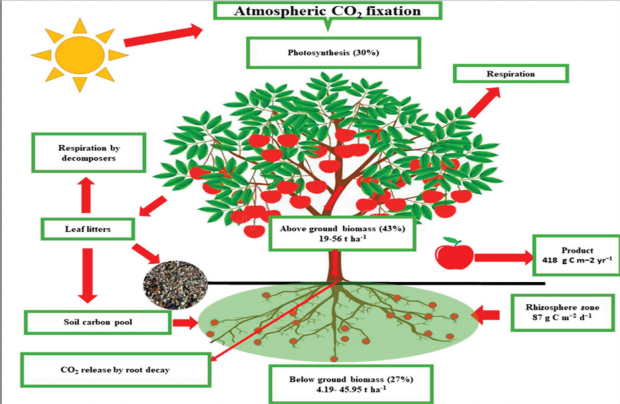The Role of Fruit Trees in Carbon Sequestration and Sustainable Land Management: A Case Study in Ethiopia
FOOD SECURITYCARBON SEQUESTRATION


Introduction
In the fight against climate change, there are several measures that could be taken to mitigate the consequences. The sequestration of carbon comes as a natural solution to remove the amount of carbon dioxide in the air. The sources that could sequestrate carbon vary from natural to technological. The following topic discussed in this blog reverts to old mother nature as a solution to carbon sequestration.
This study presented in this blog, conducted by Yohannes Gelaye and Sewnet Getahun in 2023, delves into the potential of fruit trees in Ethiopia to absorb atmospheric carbon dioxide, offering a sustainable solution for climate change mitigation.
Fruit Trees as Carbon Sinks
Fruit Trees play the role of carbon sinks by converting the carbon dioxide circulating in the air into oxygen and glucose via photosynthesis. Nature taking care of nature.
The figure below summarizes the photosynthesis process


Source: (Gelaye & Getahun , 2023)
Ethiopia's Agricultural Landscape
With an unpredictable weather environment, the agricultural sector of Ethiopia is under threat from the variance in either floods or droughts. Thus, growing multipurpose fruit trees brings much-needed aid to the problem of the weather as well as several other problems.
The benefits of cultivating fruit trees are:
Carbon Sequestration
Fruit trees store carbon in their biomass creating a sink for the carbon dioxide that will be used in growing the trees and growing the food provided by these trees.
Economic Benefits
Cultivating fruit trees brings a new stream of income to the farmers who will grow these trees which stimulates the economy.
Environmental Benefits
Planting these trees lends a helping hand in combatting soil erosion, desertification and biodiversity loss in Ethiopia in addition to extracting carbon dioxide from the atmosphere.
Food Security
Needless to say, fruit trees produce fruits that strengthen food security.
Climate Change Adaptation
Planting fruit trees is part of a broader strategy to adapt to unpredictable weather patterns, such as sporadic floods and droughts, which impact agriculture in Ethiopia.
Conclusion
The research by Gelaye and Getahun is a compelling argument for the inclusion of fruit trees in Ethiopia's agricultural practices. It presents an opportunity to combat climate change while also supporting the nation's food security and economic growth.
Subscribe to our newsletter


